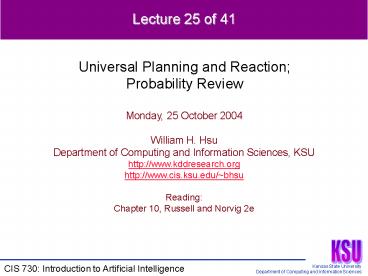CIS 730 (Introduction to Artificial Intelligence) Lecture 10 of 32 - PowerPoint PPT Presentation
1 / 12
Title:
CIS 730 (Introduction to Artificial Intelligence) Lecture 10 of 32
Description:
Kansas State University. Department of Computing and Information Sciences. KSU ... Generally want most probable hypothesis given the training data ... – PowerPoint PPT presentation
Number of Views:28
Avg rating:3.0/5.0
Title: CIS 730 (Introduction to Artificial Intelligence) Lecture 10 of 32
1
Lecture 25 of 41
Universal Planning and Reaction Probability
Review
Monday, 25 October 2004 William H.
Hsu Department of Computing and Information
Sciences, KSU http//www.kddresearch.org http//ww
w.cis.ksu.edu/bhsu Reading Chapter 10, Russell
and Norvig 2e
2
ReviewSimple Reflex Agents
3
Review 2(Reflex) Agents with State
4
Review 3 Goal-Based Agents
5
Review 4 Utility-Based Agents
6
Making Decisions under Uncertainty
Adapted from slides by S. Russell, UC Berkeley
7
Bayess Theorem 1
Adapted from slides by S. Russell, UC Berkeley
8
Bayess Theorem 2
9
Bayesian InferenceQuery Answering (QA)
- Answering User Queries
- Suppose we want to perform intelligent inferences
over a database DB - Scenario 1 DB contains records (instances), some
labeled with answers - Scenario 2 DB contains probabilities
(annotations) over propositions - QA an application of probabilistic inference
- QA Using Prior and Conditional Probabilities
Example - Query Does patient have cancer or not?
- Suppose patient takes a lab test and result
comes back positive - Correct result in only 98 of the cases in
which disease is actually present - Correct - result in only 97 of the cases in
which disease is not present - Only 0.008 of the entire population has this
cancer - ? ? P(false negative for H0 ? Cancer) 0.02 (NB
for 1-point sample) - ? ? P(false positive for H0 ? Cancer) 0.03 (NB
for 1-point sample) - P( H0) P(H0) 0.0078, P( HA) P(HA)
0.0298 ? hMAP HA ? ?Cancer
10
Choosing Hypotheses
11
Terminology
- Introduction to Reasoning under Uncertainty
- Probability foundations
- Definitions subjectivist, frequentist, logicist
- (3) Kolmogorov axioms
- Bayess Theorem
- Prior probability of an event
- Joint probability of an event
- Conditional (posterior) probability of an event
- Maximum A Posteriori (MAP) and Maximum Likelihood
(ML) Hypotheses - MAP hypothesis highest conditional probability
given observations (data) - ML highest likelihood of generating the observed
data - ML estimation (MLE) estimating parameters to
find ML hypothesis - Bayesian Inference Computing Conditional
Probabilities (CPs) in A Model - Bayesian Learning Searching Model (Hypothesis)
Space using CPs
12
Summary Points
- Introduction to Probabilistic Reasoning
- Framework using probabilistic criteria to search
H - Probability foundations
- Definitions subjectivist, objectivist Bayesian,
frequentist, logicist - Kolmogorov axioms
- Bayess Theorem
- Definition of conditional (posterior) probability
- Product rule
- Maximum A Posteriori (MAP) and Maximum Likelihood
(ML) Hypotheses - Bayess Rule and MAP
- Uniform priors allow use of MLE to generate MAP
hypotheses - Relation to version spaces, candidate elimination
- Next Week Chapter 15, Russell and Norvig
- Later Bayesian learning MDL, BOC, Gibbs, Simple
(Naïve) Bayes - Categorizing text and documents, other
applications




















![Artificial Intelligence Lecture 8: [Part I]: Selected Topics on Knowledge Representation PowerPoint PPT Presentation](https://s3.amazonaws.com/images.powershow.com/7421234.th0.jpg?_=20151128083)










